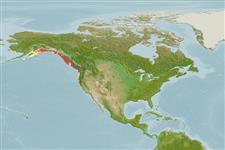Mesocentrotus franciscanus (Agassiz, 1863)
Red Sea urchin| Native range | All suitable habitat | Point map | Year 2050 |

|
| This map was computer-generated and has not yet been reviewed. |
| Mesocentrotus franciscanus AquaMaps Data sources: GBIF OBIS |
Изображение на Google |
No photo available for this species.
Классификация / Names народные названия | синонимы | CoL | ITIS | WoRMS
Echinoidea | Camarodonta | Strongylocentrotidae
Environment: milieu / climate zone / пределы глубины / distribution range экология
; пределы глубины 0 - 125 m (ссылка 95072). Temperate; 71°N - 32°N, 141°E - 117°W
Distribution страны | регионы FAO | Ecosystems | места находок | интродукции
Arctic and Northern Pacific.
Length at first maturity / Size / Weight / Возраст
половая зрелость: Lm ?, range 4 - 5 cm Max length : 19.0 cm WD самец/пол неопределен; (ссылка 128652); наибольший возраст (опубликованны данные): 200 годы (ссылка 128652)
Life cycle and mating behavior половая зрелость | размножение | нерест | Eggs | Fecundity | Larvae
Основная ссылка
ссылки | координатор | соавторы
Bisby, F.A., M.A. Ruggiero, K.L. Wilson, M. Cachuela-Palacio, S.W. Kimani, Y.R. Roskov, A. Soulier-Perkins and J. van Hertum 2005 Species 2000 & ITIS Catalogue of Life: 2005 Annual Checklist. CD-ROM; Species 2000: Reading, U.K. (ссылка 19)
Статус Красного Списка МСОП
(ссылка 130435: Version 2025-1)
Статус СИТЕС (ссылка 108899)
CMS (ссылка 116361)
Угроза для людей
Использование человеком
рыболовство: коммерческий
| FishSource |
инструменты
дополнительная информация
ресурсы в Интернет
BHL | BOLD Systems | CISTI | DiscoverLife | FAO(Publication : search) | Fishipedia | GenBank (Геном, Нуклеотид) | GloBI | Gomexsi | Google Books | Google Scholar | Google | PubMed | Tree of Life | Wikipedia (Вперёд, поиск) | Zoological Record


